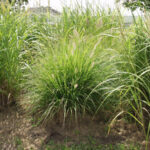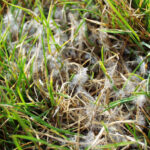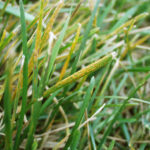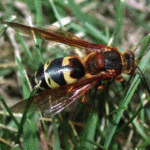Turf Tips Archives
Turf 101: Why does a November application of fertilizer work?
Nitrogen stimulates increased photosynthesis and the extra energy derived from this goes directly into growth, respiration to maintain the plant (similar to humans), or into storage. In early November, the temperature is still adequate for photosynthesis, but cool enough to minimize respiration demands and too cold for significant growth. Therefore, most of the extra energy […]
Cool, damp weather hindering fall turf work
The almost constant rain/drizzle/wet conditions coupled with early unseasonably cool temperatures have hindered progress in fall maintenance. All is not lost though because warmer and drier weather is in the forecast. Seeding: It’s too late to seed throughout IN to expect expect germination and enough maturation of the grass to survive winter temperatures. A previous […]
Keep mowing and don’t set the mower down
Many people ask how long to continue mowing into the fall. The answer is to keep mowing as long as the grass continues to grow which is normally into late October or early November. Frequency of mowing can decrease but continue to mow into the fall. Also avoid the urge to set the mower down […]
Keep mowing to mulch those tree leaves!
The trees are dropping their leaves and it is important to prevent a heavy layer of leaves from building-up on your turf before winter. Heavy layers of tree leaves will shade the grass can smother and kill grass yet this fall. Plus tree leaf cover favors a damaging winter turf disease called snow mold. The […]
Regenerating Fall Use Athletic Fields
The end is near for Fall-use athletic fields, either literally or figuratively. With the recent wet weather, football and soccer fields have taken a beating. Don’t give up on these fields yet, because after the last game or practice is when you should work hardest to improve the field. Aggressive hollow-tine aerification, pulling 20 – […]
Openings still available for MRTF Golf Day on September 30
Openings are still available for the MRTF Golf Day at The Fort Golf Resort in Indianapolis on September 30. We also have the opportunity for you or your company to sponsor a tee sign. More information on sponsorship and a PDF registration form can be found at www.agry.purdue.edu/turf/events/golfday.html or register on-line at http://mrtf.org/php/education.php#Golf. If you have any questions […]
Professionals Only: Dry weather hampers broadleaf weed control, fertilization
Though we are now in the window for maximum broadleaf weed control and fall fertilization, the dry weather throughout most of the state is hampering applications. Avoid herbicide and/or fertilizer application to drought stressed or dormant turf to limit turf damage and maximize intended effect of the application. On turf that’s still green (like in […]
Controlling escaped fountaingrass in a lawn.
Fountain grass and other ornamental grasses have added tremendously to landscapes of homes, commercial sites, and golf courses. However, we are now seeing some of these grasses escape from the ornamental beds into the turf. One in particular is fountain grass (Pennisetum spp) because it produces viable seeds which blow into surrounding turf and may […]
Cool temperatures allow a jump on beneficial fall maintenance practices
The recent record or near record low temperatures combine with adequate soil moisture is advantageous for our cool-season turfgrasses, especially compared to the typical August-September heat and drought. Fall fertilization can begin anytime, especially with rain in the forecast to help water in the application. White grub damage will likely be minimal with overall health […]
Damping off diseases in new seedlings
Although the cool weather tends to limit disease in new seedlings, a spike in the temperatures could trigger outbreaks in juvenile turf yet this year. Late summer is clearly the best time of the year to seed for a variety of reasons, but we must deal with two difficulties of seeding at this time: Our […]
MRTF Golf Day at The Fort in Indianapolis on September 30
Openings are still available for the MRTF Golf Day at The Fort Golf Resort in Indianapolis on September 30. This annual event is held to promote turfgrasss research, raise awareness of the Purdue Turfgrass Science Program, and provide an enjoyable day of golf. With a centralized location and afternoon shotgun start we hope to draw […]
Tall fescue for Indiana lawns but not most sports fields
Tall fescue is a great turf for lawns throughout most of Indiana. It requires about ½ the nitrogen and far less irrigation than Kentucky bluegrass when managed for the same aesthetic appearance. Because of its deeper rooting and access to water in the soil, it stays greener than Kentucky bluegrass much longer into a drought. […]
Drought affects all turf areas differently
We are fielding a number of calls like “Why is my lawn is turning brown while my neighbors isn’t, even though neither of us irrigate?”. On any given turf area or in a neighborhood, we can see a wide variety of responses to the current drought. Following is a list of factors that will affect […]
How much perennial ryegrass/Kentucky bluegrass in a mix?
With the renovation season here, questions abound about how much perennial ryegrass to use in a P. rye/K. bluegrass mix. Perennial ryegrass germinates quickly and provides quick cover and soil stabilization when used in a blend. However, too much perennial ryegrass leads to long-term problems from dollar spot, brown patch, red thread, and other diseases. […]
Now is the Time to Start Improving Your Lawn
Tired of the way your lawn looks? If it hasn’t looked up to par this summer with the relatively good weather, it never will and reseeding your lawn is an option. Mid-August is the best time to seed a new lawn or overseed an existing lawn. If the lawn is just thin and needs a […]
For professionals: Avoid late summer weed control
Though this summer has been pretty kind for our cool-season grasses, a number of weeds may be at high enough populations to become problematic. With temperatures forecast in the high 80’s or 90’s for the next week, it is probably best to leave the herbicides locked in storage. Plus most of the problematic weeds (crabgrass, […]
Dollar Spot
Dollar spot is caused by a fungal pathogen, Sclerotinia homoeocarpa, that blights leaf tissues but does not affect turfgrass roots or crowns. The disease is a common concern on golf course turf, especially creeping bentgrass and annual bluegrass greens, tees, and fairways, where it can result in poor turf quality and appearance. Dollar spot is one […]
Rust Diseases
Rust is a disease of taller mown turf. Outbreaks are most common on residential lawns, low budget athletic fields, and, occasionally, on golf course roughs. A variety of related fungi cause rust. Ccommon names include leaf rust, crown rust, and stem rust, and the disease occurs almost exclusively on Kentucky bluegrass and perennial ryegrass. Rust […]
Professionals only: Rust/dollar spot thriving in lawns
The diseases rust and dollar spot are thriving in Indiana lawns right now, which is fairly typical for this time of the year. These are both low nitrogen diseases, so are almost inevitable as we try to keep lawns on the lean side during the summer to minimize devastating damage from pythium, brown patch, heat […]
Cicada killers: A Nuisance or a Danger?
A number of solitary bees and wasps reside in turfgrass and landscapes. Because of their ability to harm humans, these insects often evoke a great deal of anxiety. However, in reality they very rarely sting. Education is the single best strategy to help people deal with cicada killers. Cicada killers are one of the largest […]



